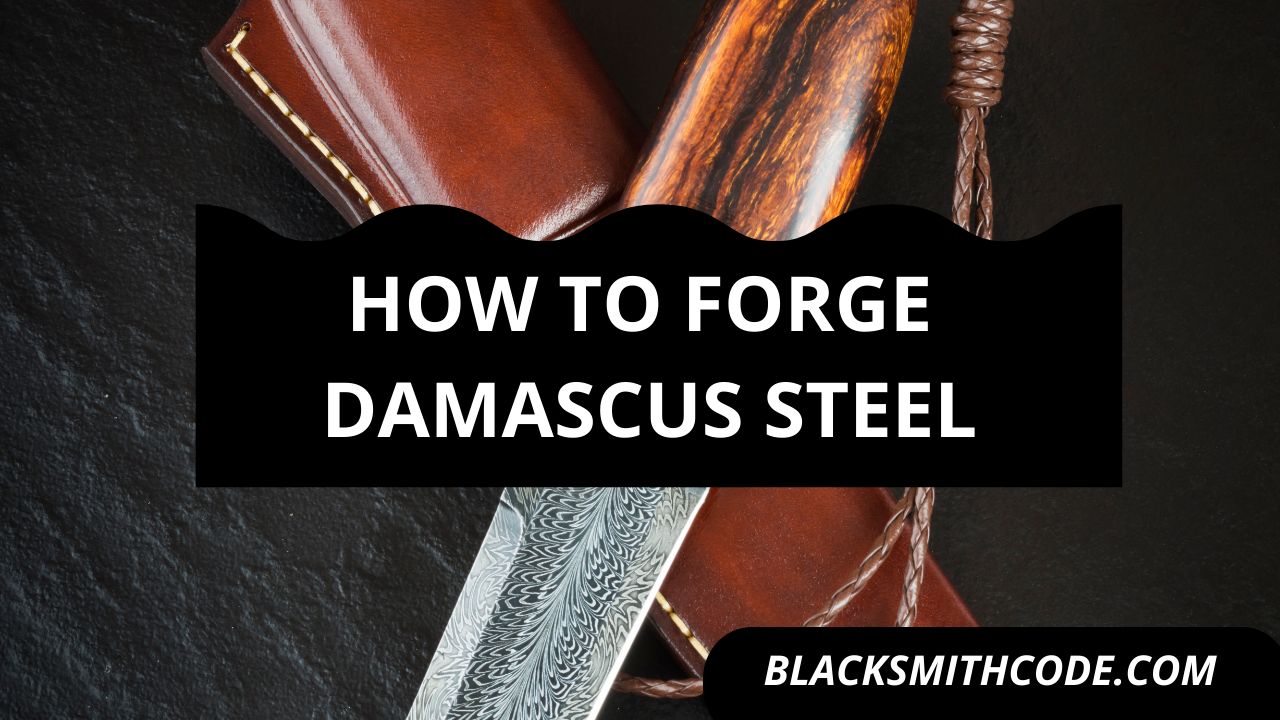Do you know blacksmiths also forge steel with unusual patterns? Damascus steel is one such pattern. So, it feels great to learn how to forge damascus steel.
Including patterns as part of finishing makes blacksmith projects more appealing and beautiful. It also adds a touch of class, professionalism, and unique design to projects.
Damascus is a dynamic type of steel; it has an etched pattern that makes it unique and stands out. Every step taken when forging Damascus steel appears to be very professional.
However, it is one of the most beautiful blacksmithing works. The good news is that learning how to forge Damascus steel is not as difficult as it appears to be. You can learn how to forge Damascus steel with ease within short time.
Below are easy and practical steps to make Damascus steel.
Essentials
The process of forging a Damascus steel usually requires some essential materials. Aside from the materials used for forming, it would be best if you also had specific tools. The essentials for carrying out this forging process include;
Instructions
Step 1: Get Your Materials and Tools
This is the first step in forging Damascus steel. The availability of your materials is essential for the entire process. Make sure you keep the essential materials close before starting the process.
You would need flux, long rod metal scrap, ferric chloride, brass pins, quenching oil, rebar, and a finishing medium. The tools are nothing differ from the regular blacksmithing tools, including anvils, hammer, and tongs.
You have to gather the materials you want to use from various sources, including scraps. You can quickly rough-forge these different materials to form your billets.
Step 2: Assembling
Once you have your materials ready, the next action is to start assembling your billets. Billets are the pieces of steel you put together to form your Damascus steel. Billets come as individual entities and you have to start by putting them together.
Cut the materials into your desired dimension to make Damascus steel. However, it is best to cut your billets in vast proportions. The cutting requires precise measurements because the size of billets will largely influence the process.
The larger the billets, the easier it is to form the Damascus steel with the hammer. Also, ensure the proper oxidation and scale removal of the metal to obtain a clean forge. Scale removal will prepare the surface and mitigates the possibility of a negative interference.
Pro Tip
It would be best if you were careful with this process because it forms the layer of Damascus steel. Also, it determines the strength and durability of steel, which can influence the overall quality of the project.
Align the layers together and forge a temporary handle. The handle’s essence is to be able to move the material in and out of the forge.
Step 3: Heating
Now, it is time to put your forge to reasonable use. Heating is one of the basic steps in the blacksmithing process, and forging Damascus steel. Prepare your forge and start heating it.
Fire your forge up to a temperature between 1500-2000℉, which is usually the range of Damascus temperature. However, there is no fixed temperature for this step. But ensure that you heat the billets until it becomes sparkling red.
The temperature can vary depending on the type of Damascus steel you are trying to create. It can also be dependent on the type of steel you are using. The overall steps involved in the heating process of Damascus steel are;
Quick Steps
- Preheat and fire up your furnace to a suitable temperature [Usually between 1500-2000 degrees Fahrenheit]. Find a way to estimate the temperature and ensure that it is within suitable range.
- Put the block of assembled billets inside the forge for heating and leave it for sometimes
- Keep heating the billet until it becomes cherry-red.
- Prevent oxidation by keeping oxygen away from the metal to give you a clean weld
- Watch the steel heat up to the desired temperature before removing it.
- Quench rapidly in water or quenching oil for about 10 minutes until the temperature normalizes.
- Alternatively, you can soak it in water first, and then soak it in blacksmiths quenching oil.
- Repeat the process for about 2-3 times, depending on the type of Damascus steel you intend to create.
- Pass the iron through liquid hydrogen for about an hour to complete the process.
Step 4: Tempering
Once you are through with the heating process, it’s time to do some tempering. The tempering process aims to increase the strength and durability of the material.
Tempering usually takes place at a precisely controlled temperature. This process will not give you the required result if you don’t carry it out at an accurate temperature.
Quick Steps
- Temper your steel at 350-450℉ for about an hour.
- Repeat the steps a few times until you achieve a satisfying result. More like cooking until it is done.
Step 5: Etching/Finishing
This is the final step of the forging of a Damascus steel and it is often a defining step. The etching process and the finishing usually go hand in hand, more like a ring on the finger.
This step usually determines the design display of steel. It requires some precise but simple steps. So, feel free to be creative and flexible about the process.
- Spread over a grit finish over the surface of your steel.
- Prepare for your etching process.
- Dilute your ferric acid in a container according to the manufacturer’s instructions. The quantity of the solution can be a factor in the amount of steel you are creating.
- Immerse the iron in the diluted solution for a stipulated period. Usually, the time for the immersion is always stated according to the manufacturer’s instruction.
- Rinse the steel under clean water and let it dry.
- Repeat the immersion process after 5-7 minutes.
- After you have achieved your desired result, you can neutralize the steel by passing it through tri-sodium phosphate.
FAQs on how to forge damascus steel
Question
What are the different types of Damascus steel?
There are different types of Damascus steel. These types are divided into two types, which are the Wootz steel and Pattern-weld steel. The primary feature of Wootz Damascus steel is that it does not undergo any artificial process.
Pattern-weld steel, on the other hand, is basically from different pieces of metal. Wootz Damascus is considered as the real Damascus while Pattern-steel, on the other hand, is regarded as the counterfeit.
Question
What can I make from Damascus steel?
Damascus steel has the property that allows you to forge any time of blacksmithing products. They are utilized for forming different types of products, including a knife, sword, blade, and so on.
Question
Can I make Damascus from scraps?
Yes. You can create your Damascus steel from scraps. All you need to do is to rough-forge these scrap materials into a billet. Then from there, you can continue with the forging procedure.
Question
What are billets?
Billets are small sections of metals that can form more prominent metals. You can roll it into bars, units, and rods. Billets are usually produced by continuous casting or with ingots.
Billets are useful for various metal processing operations, including forging, rolling, and metal-related processes.
Question
What makes the pattern in Damascus steel?
Damascus steel is an assembly of billets rolled up and heated together to form metal of precise shape and pattern. During this forging process, the small billets will melt together to form a proper shape.
The heating process causes the iron carbides to align into bands, which in turn create unique patterns. The patterns usually imitate the grains in wootz steel from ancient India.
Question
What is unique about Damascus steel?
A lot of people view any object made from Damascus steel as one with high quality. One of the unique things about Damascus forging is its unique dark pattern with light or wavy light.
It has a high value because it is rigid and flexible at the same time. For instance, weapons made from Damascus steel are generally superior to other metals and other materials.
Question
Does Damascus steel form better blades?
Damascus steel is the best metal you can use to form blades and other weapons. High-quality Damascus steel will give you sharper and more durable steel. It is also stiff and flexible, which is one of the core properties of blades.
Question
Is Damascus steel A lost art?
No! Damascus steel is not a lost art. The art was indeed lost in the 18th century, but it gained a resurgence later in the 19th and 20th centuries. It has been growing increasingly popular since its resurgence.
Question
How many layers does Damascus steel have?
Multiple layers are one of the unique properties of Damascus steel. The number of layers is determined by the number and layer of billets in use.
On average, Damascus steel has a minimum of 300 layers. You can always forge Damascus with more layers.
Question
Why does a blacksmith hammer a metal as it cools?
Hammering is an essential procedure in blacksmithing, and blacksmiths hammer metals as they cool for many reasons. First off, blacksmiths hammer metals to give them precise shape and form. Also, blacksmiths hammer metals during hardening and tempering.
Question
Does Damascus steel rust?
Most Damascus steel is made from high-carbon billets with a trace amount of chromium in the alloy. So, Damascus steel can rust if you do not take proper care.
Protect your meals from rust by keeping them away from water and moisture. Also, make sure you keep the metal clean and away from dust.
Question
Can you forge Damascus steel by hand?
Forging Damascus steel by hand is possible. But it does not mean you don’t need the right materials and tools for the process.
Question
How to make Damascus steel?
Damascus steel is ancient steel used in making sword blades. They are notable for their hardness and tough characteristics. The Damascus steel has its legend based on its superplastic flexibility and hardness.
The Damascus steel’s chemical composition gives it the ability to cut through rifle barrels and even strands of hair. Forging Damascus steel requires you to heat metal ingots to a required temperature. You can also heat the metal ingots alongside leaves and glass to prevent oxidation.
After heating the metals, you will have to hammer it while hot. You can beat the metal till it cools and reheat again to repeat the process. Forge the metal into the preferred shape by hammering, cutting, etc.
Question
How do I forge Damascus steel?
Forging Damascus steel requires you to follow simple steps. The Damascus steel is flexible, ductile, brittle, and hardened steel, so you have to put these qualities in mind when forging it. Before you start forging the steel, you should get the materials you need for the forging process.
You will need to get metal ingots for forging your Damascus steel. Metal ingots are relatively pure metals cast into shape for further processing. The metal ingot is essential for the forging of your Damascus steel.
You have to heat the metal ingot to a high temperature. When heating the metal, you should add leaves and glass to the crucible to heat them alongside the metal ingots. Heating the glass and leaves with the metal will help prevent oxidation.
After heating the metal, you should hammer it to your desired shape. When the metal cools, you should reheat and beat it. You can repeat the procedure as much as you want, and you have your Damascus steel prepared.
Question
What are the types of Damascus?
There are two types of Damascus used in custom sword and knife making. One of Damascus’s kinds is the pattern-weld Damascus that has the appearance of the original Damascus steel. The other type of steel is the wootz, mostly referred to as the true Damascus.
The wootz has legendary strength and sharpness, with its method of forging lost to time. The two types of Damascus display complex patterns on the surface due to the steel’s structural elements. The patterns of the steel are a result of the forging process and method.
Question
How do you make Damascus steel?
The Damascus steel comes from the welding of iron slices and several types of steel together. To make Damascus steel, you have to heat these metals together and hammer them to your preferred steel shape. The iron slices and steel form billets, which later transform into Damascus steel through forging processes.
Question
How to forge Damascus?
To forge Damascus, you will need to get the tools and materials you will use prepared. After getting the materials, heat the metal in a forge alongside other necessary ingredients. After the metal gets hot, hammer it into your preferred shape and size.
When the metal cools, you should heat it back to a high temperature. You can repeat the procedure as much as you want. You can now further into shaping, cutting, or other finishing processes.
Question
How to make Damascus steel billet?
It is very easy to make Damascus steel billets. To make the billets, you will need to weld different types of steel and iron slices together. You can weld them by subjecting them to a high amount of heat till you get your desired result.
Question
Is Damascus steel expensive?
Damascus steel is relatively more expensive than other types of metals. But you will certainly get the worth of your money because of the quality of the material.
Question
What are the essential tools for forging Damascus steel?
Damascus steel forging does not require any unique tool aside from the general blacksmithing tools. Some of the essential tools for forging Damascus steel include forge, hammer, and tongs.
Question
Can blacksmiths use a foot-powered blacksmith hammer for forging Damascus steel?
Yes, blacksmiths use various types of hammers for their processes, including foot-powered blacksmith hammers. You can learn how to make foot-powered blacksmith hammers and how to use them as well. It can help you to execute the forging process with ease.
Video
Warnings
It is crucial to take some precautions while forging your Damascus steel. For blacksmiths, it is safety first. Also, these precautions will help you to achieve your desired result.
- Ensure that you only heat Damascus steel to a suitable temperature, especially during tempering.
- Be careful while working with such high temperatures during heat treating.
- Ensure that you put on your protective gear while carrying out these processes.
- Observe other blacksmithing safety procedures.




